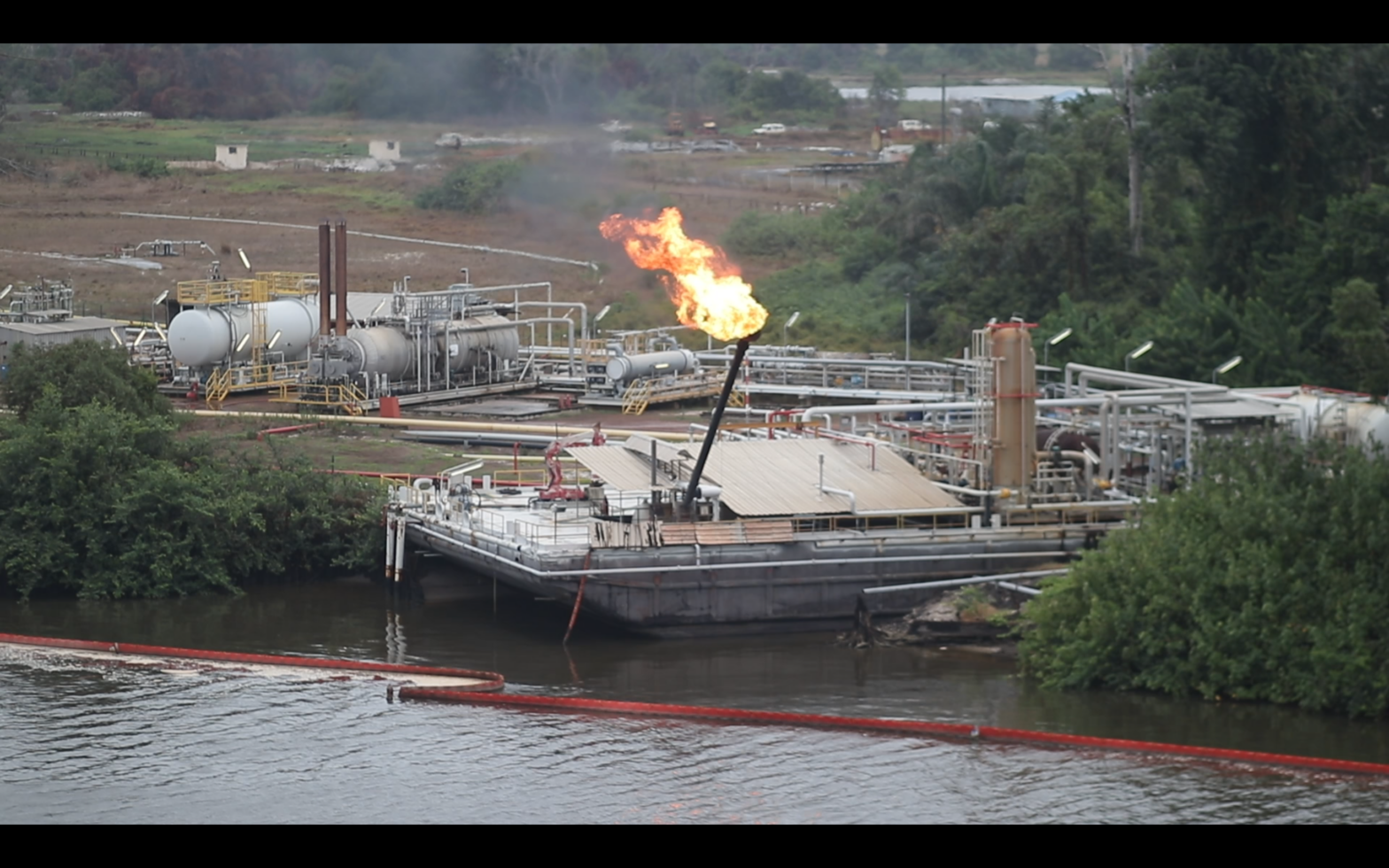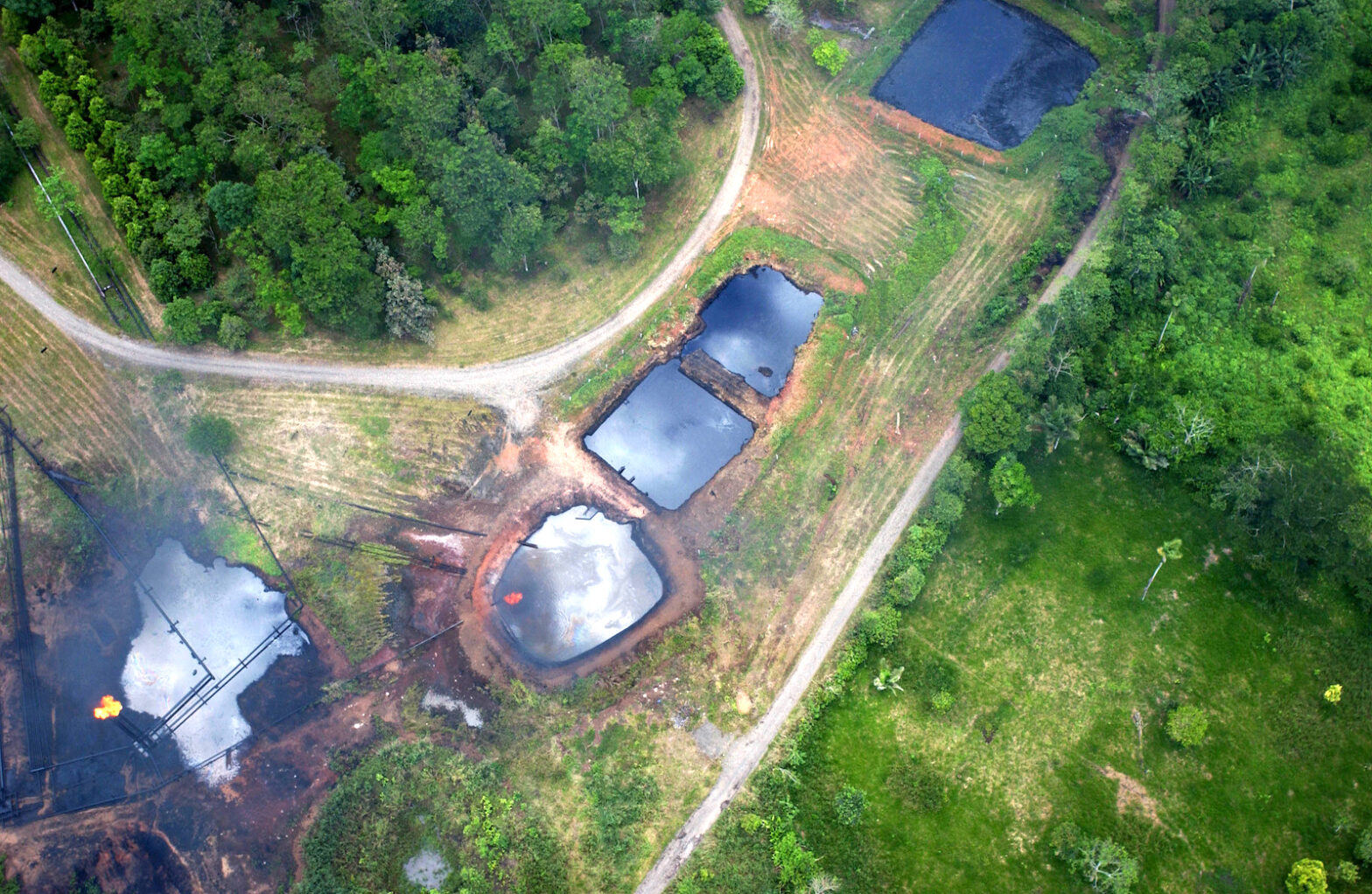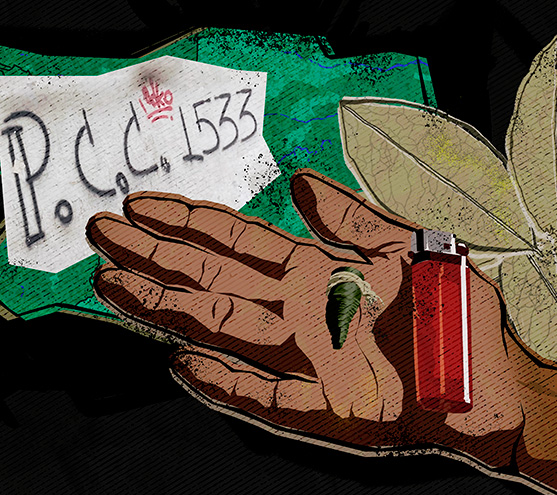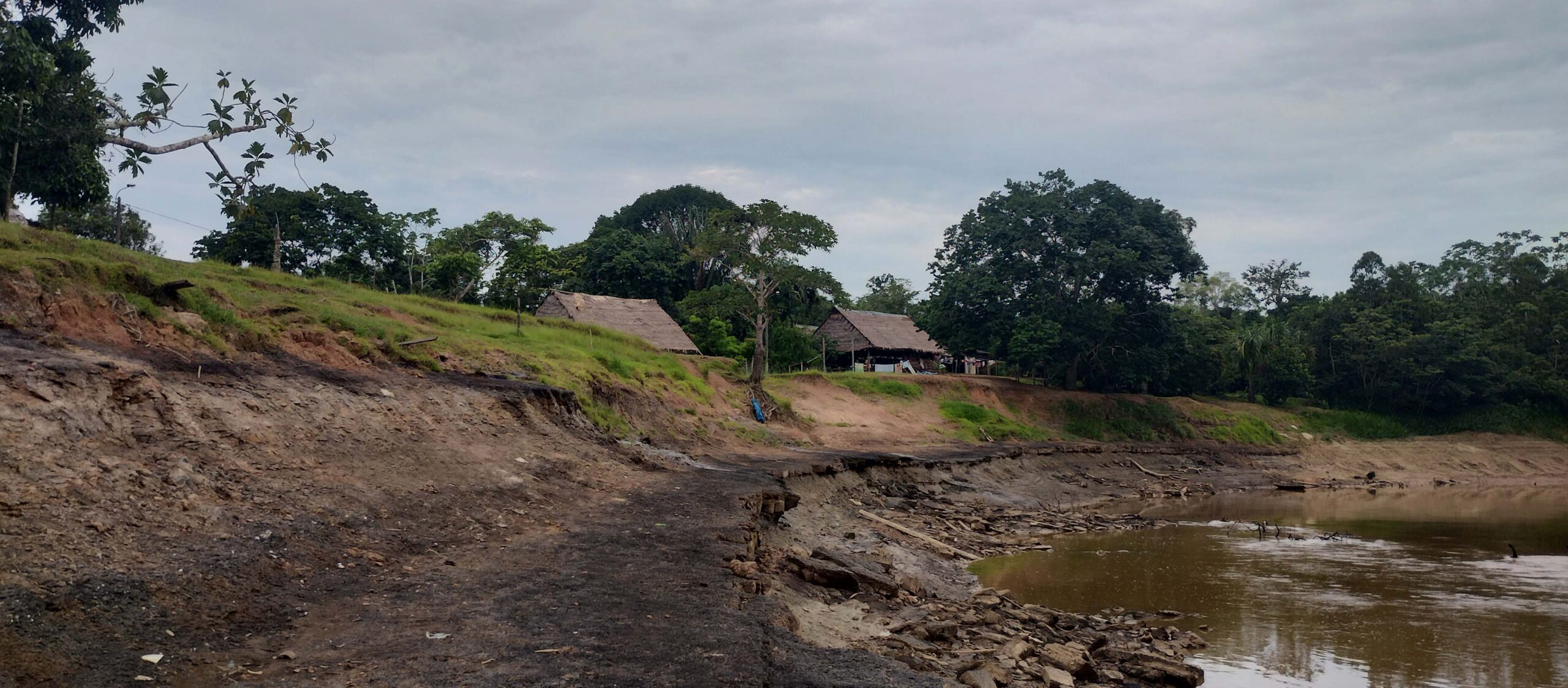
Entrance to the native community of Flor de Coco, located in the indirect influence area of Perenco, but the closest in terms of river route to the Arabela River. Credit: Pamela Huerta/InfoAmazonia
The dry season in Peru’s Amazon rivers should have ended in October, but in early November, water levels were still very low. Navigating them was complex, but the final destination of this investigation was the native communities of Buena Vista and Flor de Coco, in the department of Loreto. These are the only two communities of the Arabela ethnic group in Peruvian territory and the closest ones to the area under direct and indirect influence of Perenco Perú Petroleum Limited’s concession areas in the Amazon rainforest.
No public or private transportation with regular routes reaches those communities. Starting from Iquitos – the capital of the Loreto region – it may take two days to get there in a medium-capacity river boat. However, it could take up to a week in a peque-peque, a wooden boat used daily by community members.
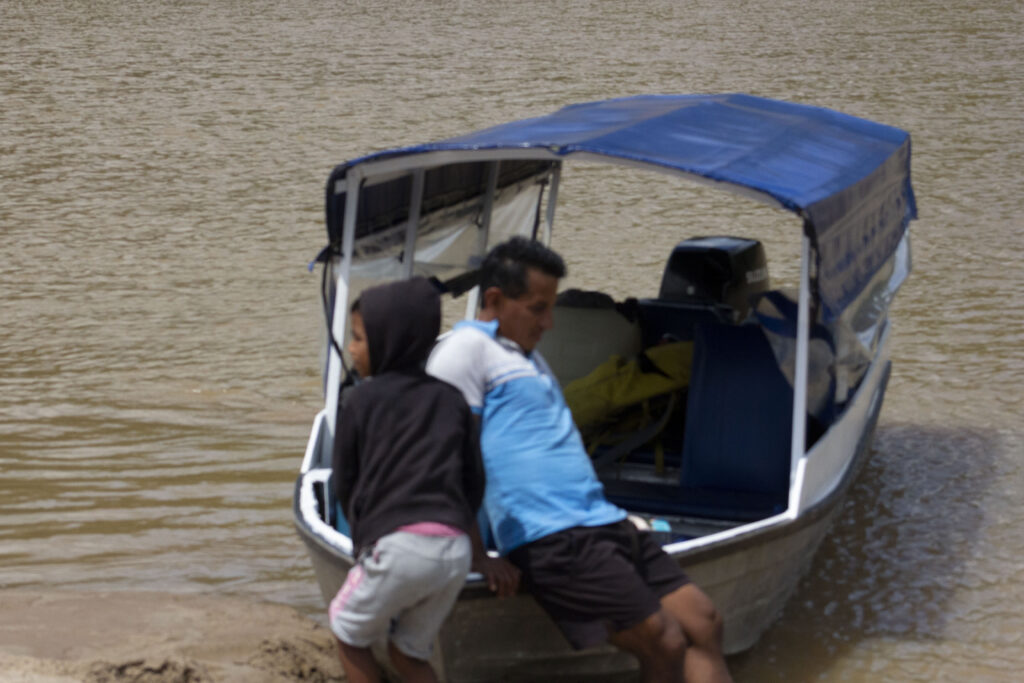
In this remote, out-of-reach territory that should be protected after Peru’s Ministry of Culture (Mincul) confirmed the presence of isolated indigenous peoples with initial contact (PIACI, in its Spanish acronym), Perenco has been charged with 58 environmental violations in ten administrative sanction procedures that the company managed to hide from the indigenous population directly affected. These are the results of an InfoAmazonia investigation on the activities of the company around the world, in collaboration with the international consortium of environmental investigative journalists EIF, InfoCongo,Convoca and Mediapart.
What Perenco did not say
Perenco is an oil company established in the country since 2008, having signed its first contract with the Peruvian State for the concession of Block 67. At that point, the oil exploration and exploitation area had 150,277 barrels of proven oil reserves. Former Peruvian president Alan García hailed the project as a “miracle” for the country, praising the wave of development and ignoring the rights of the indigenous peoples who lived in those territories – mainly Kichwas and Arabelas.
“We are certain that the next two or three years will enable the country to become an oil exporter again, after having ceased to be one 20 years ago”, the now deceased president declared in 2009, after Perenco chairman Francois Perrodo visited the government headquarters to announce an investment of more than 2 billion dollars to develop its oil field.
But such desire for prosperity had an additional cost: the violation of the rights of indigenous peoples. Just four days after Perrodo’s visit to Peru and in the midst of one of the bloodiest social conflicts in the Amazon in recent times – the Baguazo – the government enacted Executive Order 044-2009-EM to declare “the development of the Block 67 project as being of national necessity and interest.” The rule enabled loosening environmental regulations and skipping administrative procedures that were crucial in a project of such magnitude.
A study on the actions of oil companies Perenco and Maurel, prepared in 2016 by civil society organizations The Amazon Center for Anthropology and Practical Application (CAAAP) and CooperAcción, demonstrated how the concession of Block 67 failed to include prior consultation and imposed the concept of occupation easement. Therefore, a right recognized by Convention 169 of the International Labor Organization (ILO) was ignored in exchange for economic compensation. Proper participation mechanisms were not implemented for the communities involved, which were treated as mere recipients of information.
Furthermore, no identification of socio-environmental impacts or the execution of mitigation measures was guaranteed, according to CAAAP – environmental management instruments are established to measure the potential environmental impact of a project. Environmental impact assessments (EIA) did not correctly define the areas of direct and indirect influence and ignored precautionary measures aimed at safeguarding the rights of indigenous peoples.
Regarding this last point, the Regional Organization of Indigenous Peoples of the East (ORPIO) had requested the establishment of the Napo-Tigre reserve for uncontacted peoples in 2005, three years before Perenco took over the concession area. In addition, the People’s Defender Office had opposed any type of economic activity within that territory, at least until a transit corridor was delimited for indigenous people in isolation or initial contact.
According to the Defender’s Report 101-2006, “no third-party use rights should be granted over the resources in their territories before the buffer zones of said areas are demarcated.”
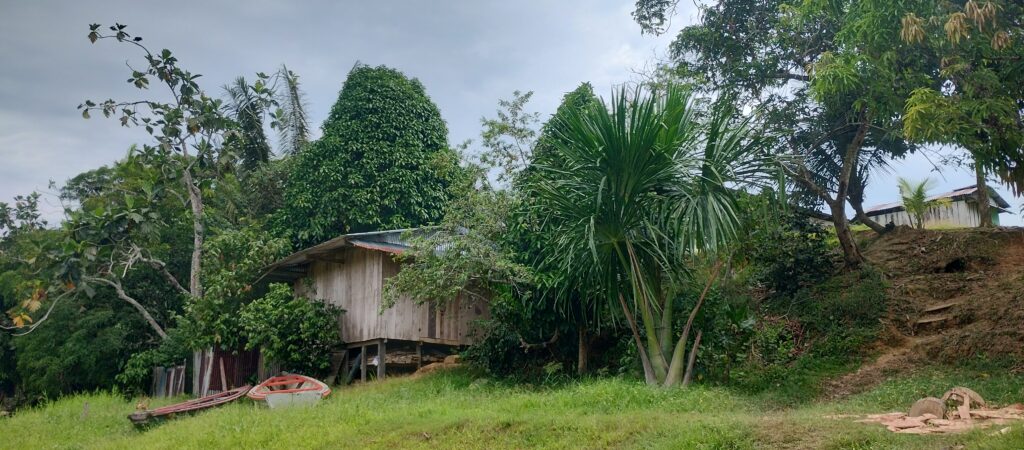
For the Buena Vista native community, the arrival of the oil company meant prosperity. Families benefited directly and indirectly from the economic flow generated by the project in their territory. Houses began to be built with quality materials, dirt paths were paved, new businesses were opened, and jobs were created for community members. Everything seemed to point to a win-win situation.
In a community assembly in which InfoAmazonia team participated in October 2023, they acknowledged feeling that someone had finally looked at them.
In parallel, Perenco accumulated administrative sanctions by Peru’s Environmental Assessment and Enforcement Agency (OEFA, in its Spanish acronym) for failing to comply with the parameters set in environmental management instruments and environmental quality standards, and exceeding maximum limits in several operations.
Pilar Cabrera, president of the Federation of Native Communities of Alto Curaray and Arabela (Feconaca), said she was surprised when she was interviewed for this publication because, even though she kept direct contact with Perenco, the company never informed them about possible environmental impacts.“I’m not aware of any sanctions against Perenco for pollution issues. Communication has always been sort of empty in that regard; we were never given details of what was happening. We always kept direct contact, but these issues have never been addressed,” said the Arabella leader.
I’m not aware of any sanctions against Perenco for pollution issues. Communication has always been sort of empty in that regard; we were never given details of what was happening. We always kept direct contact, but these issues have never been addressed.
Pilar Cabrera, president of the Federation of Native Communities of Alto Curaray and Arabela
According to data from the Single Register of OEFA Sanctioned Environmental Violators (RUIAS) retrieved from the Convoca Deep Data platform, our investigation found that Perenco was held responsible for 58 violations in ten administrative procedures between 2015 and 2022. They included 32 violations (55.17%) for non-compliance with environmental instruments, 11 (18.9%) for exceeding maximum limits for gas emissions (domestic effluents, phosphorous, nitrogen oxide), six (10.3%) for improper storage of waste and chemicals, four (6.9%) for oil spills, two (3.4%) for impacts on water, and three (5.17%) for failing to disclose full environmental information.
As a consequence of these sanctions, the company accumulated fines totalling 1,389,271.95 Peruvian soles or approximately 400,000 US dollars and was ordered to carry out 16 corrective measures. However, economic sanctions were only imposed on 47% of the violations, since Perenco resorted to Law 30230 to exchange them for more corrective measures. That rule was intended to promote private investment by limiting OEFA’s sanctioning power and placing the institution as a mere supervisor of any environmental damage.
Perenco committed 58 environmental infractions in Block 67 between 2015 and 2022. More than half of them were due to non-compliance with environmental instruments, and the rest for exceeding maximum limits in gas emissions, improper storage of waste and chemicals, oil spills, providing incomplete environmental data, and water contamination.
“In the cases in which fines were not imposed on the violations described, it should be noted that this was due to the fact that the corresponding administrative sanctioning procedure was processed under article 19 of Law 30230. Therefore, no financial sanction has been imposed – to date – regarding said violations,” OEFA told this investigation.
Our investigation found that Perenco underwent two other administrative sanction procedures in 2017 and 2022, which are awaiting resolution. If these sanctions are confirmed, Perenco would have undergone 12 such procedures for over 60 violations.
InfoAmazonia contacted the company to ask about the socio-environmental impacts it left during its operation in Loreto, but they only responded the following:
“Perenco has been operating in Peru since 2008 and is proud to have played its part in the successful development of Block 67, a project declared of national importance by the Peruvian Government. It has been developed on an incredibly small scale to minimize its environmental impact. Block 67 has not been producing since the closure of the North Peruvian Oil Pipeline (ONP),” the company’s spokesperson stated.
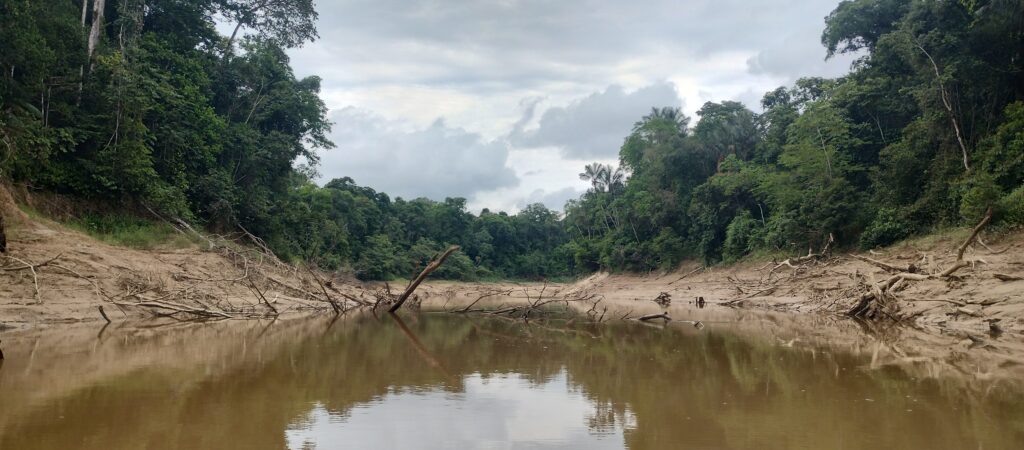
Damage perception
Jack Jimo is an Arabela resident of the Buena Vista native community and has worked as an environmental supervisor at Block 67 since 2010. He is a strong, serious man who approved of the “progress” brought by Perenco. His job was to supervise operations in camps and surrounding areas assigned to him. He worked 28 days and rested the other 28. He says he was always attentive to compliance with the parameters established in the environmental management instrument on which he had been trained. However, he recognizes that he faced limitations to do his job.
On one occasion he had to report on stagnant sewage in a creek near the Dorado field – one of the three deposits of Block 67. It had been obstructed by heavy machinery that passed over its bed, affecting half a hectare around it. “The creek was blocked up because many trucks were passing through. It all dried up and became lifeless, but it has been solved. They opened the ditch again, and they have cleaned it up and reforested it,” says Jimo, confirming that the waste reaches water currents that end up in the Arabela River.
One of Perenco’s recurrent violations is related to domestic effluents – that is, wastewater from bathrooms and kitchens. According to the case files to which this investigation had access, maximum limits were exceeded on at least six occasions for parameters such as hydrogen potential (pH), phosphorus, oils, fats, ammoniacal nitrogen, residual chlorine, chemical oxygen demand (COD), biochemical oxygen demand (BOD5), total coliforms, and faecal coliforms.
From 2012 to 2013, biologist Jefferson Eras conducted a hydrobiological study on the Arabela River, including chemical and physical tests, but he says he was unable to access the results. What he does know is that the tests found damage from heavy metals in fish from the basin. “Another study was conducted, but after seeing the damage done to the fish, we demonstrated that they had heavy metals in their bodies, causing them to have larger heads and shorter bodies. Then we released a list of fish whose excessive consumption should be avoided,” he recalls.
The last sanction that Perenco received from OEFA was for failing to monitor surface water – that is, to measure its external components to evaluate the parameters and identify or prevent any environmental impact – as mandated by its environmental management instrument in the second half of 2019.
Verónica Portugal, an environmental engineer at Peru’s Scientific University of the South (UCSUR), observes that Perenco’s lack of transparency was evident when it failed to provide information on the spill reports given to the authorities, but also in its lack of a preventive approach.“The processes must be regulated. In this case, besides exceeding the maximum limits, there is a prevention problem, because water and air are not monitored… So you don’t know whether or not you are creating some type of effect. You can’t measure the impact on the environment,” Portugal warns.
The processes must be regulated. In this case, besides exceeding the maximum limits, there is a prevention problem, because water and air are not monitored… So you don’t know whether or not you are creating some type of effect. You can’t measure the impact on the environment.
Verónica Portugal, an environmental engineer at Peru’s Scientific University of the South (UCSUR)
Jack Jimo remembers that an outside company came periodically to monitor water, air and soil in the area. He and other environmental supervisors participated in collecting samples for that evaluation and always asked to see the results, which they were never given.
“The company came to conduct the tests; we accompanied them in the sampling, we all did the management. They’d take it to the lab and the results were given to Perenco, but we never knew those results. We asked to see them, but the company always said that the report was not available yet,” Jimo explains.
They’d take it to the lab and the results were given to Perenco, but we never knew those results. We asked to see them, but the company always said that the report was not available yet.
Jack Jimo, resident of Buena Vista and environmental inspector for Block 67
But the neglect toward water bodies is compounded by oil spills. Although the files of the administrative procedures say that there was no direct impact on the inhabited parts of the area under the project’s direct and indirect influence, the company never owned up to the problem as it should, accumulating five oil spills between 2014 and 2020.
“Perenco would have failed to adopt measures to avoid adverse environmental impacts on the soil in the pool area of the Piraña CPF of Block 67 and the Flare area of said CPF that resulted from crude oil spills. Moreover, it did not properly storage hazardous solid waste generated as a result of cleaning the areas impacted by the oil spills,” OEFA says in its report detailing the spill that occurred on February 11-12, 2014.
This was recurrent until 2019.“Perenco failed to adopt preventive measures to avoid adverse environmental impacts as result of the oil spill that occurred on September 13, 2019 in the CPF Process Zone of Block 67, with potential damage to wildlife,” OEFA warned again in another report, pointing out a pattern in the company’s behaviour.
Perenco failed to adopt preventive measures to avoid adverse environmental impacts as result of the oil spill that occurred on September 13, 2019 in the CPF Process Zone of Block 67, with potential damage to wildlife.
OEFA’s report
Violations associated with possible damage to air and soil were also constant.
The files included violations of maximum permissible limits for gas emissions from the flare, a procedure for gas burning as a result of hydrocarbon exploitation. Benzene, sulphur dioxide, nitrogen oxides and others. According to the descriptions of violations sanctioned by OEFA up to 8 times, “maximum permissible limits for gas emissions were exceeded,” in addition to failing to monitor gas emissions.
Silence and disappointment
The boat departs from the Buena Vista native community to continue travelling the Arabela River. We are not sure about continuing the journey. The water level has dropped so much that we ran aground three times trying to avoid huge logs. Finally, we arrived at Flor de Coco, the first territory to be affected if an oil spill reached the waters of the river. Orlando Rosero, a 64-year-old wise man, watches from a small slope, greeting us in his native language and asking why we were there. It is explained to him that this is a journalistic investigation about Perenco, and he puts on a disappointed face.
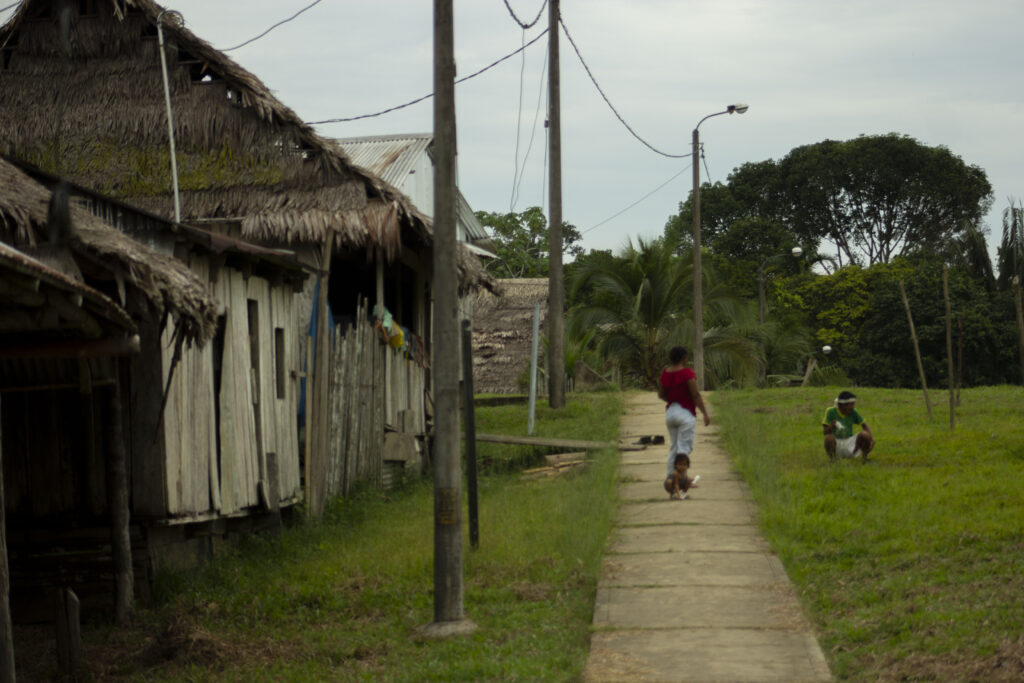
“They have always seen us as a community of indirect influence. I don’t know why! First, we used to live in the old Buena Vista, where Perenco is now, and we came to live here as an extension of the new Buena Vista. Why? Because in new Buena Vista there was not enough area for all of us to build our little houses. You know it’s wetland back there. And when it floods, everything gets covered by water. That’s why we came here. That’s why they consider us as an indirect community,” Rosero explains.
He began by narrating that displacement because until 1981 – according to the same people – the Flor de Coco native community used to be connected to the old Buena Vista, the first Arabela settlement. They became two different communities when they went out in search of supplies. “In the past, the mouth of the Arabela River was two and a half days away in a peque peque. That’s where we can get phosphorus and salt, and some boats couldn’t get in because it’s rocky,” Rosero said. It used to cover what are now their new territories divided into two communities: the new Buena Vista and Flor de Coco. That is why they resent Perenco and the Peruvian State – because they feel that their history and origins are being ignored.
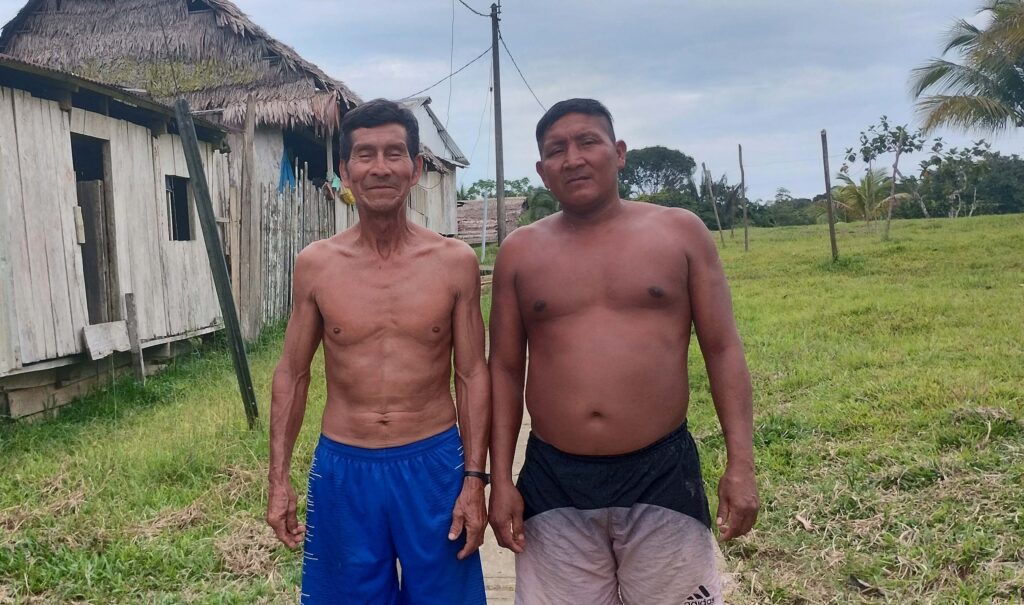
But also because they consider that their expectations were played with when they were promised productive projects and access to water for human consumption through the company’s community relations area.
Jerónimo Manihuari is the apu, or chief, of the Flor de Coco native community. He says that the oil company came with several offers, but they were never concluded. “Perenco came to give talks and supported productive projects, but what can I tell you? There was no technical support, no follow-up… There was a water and drainage project so we wouldn’t need to take water from the river, but it’s not operational so far. It has never come true,” he says.
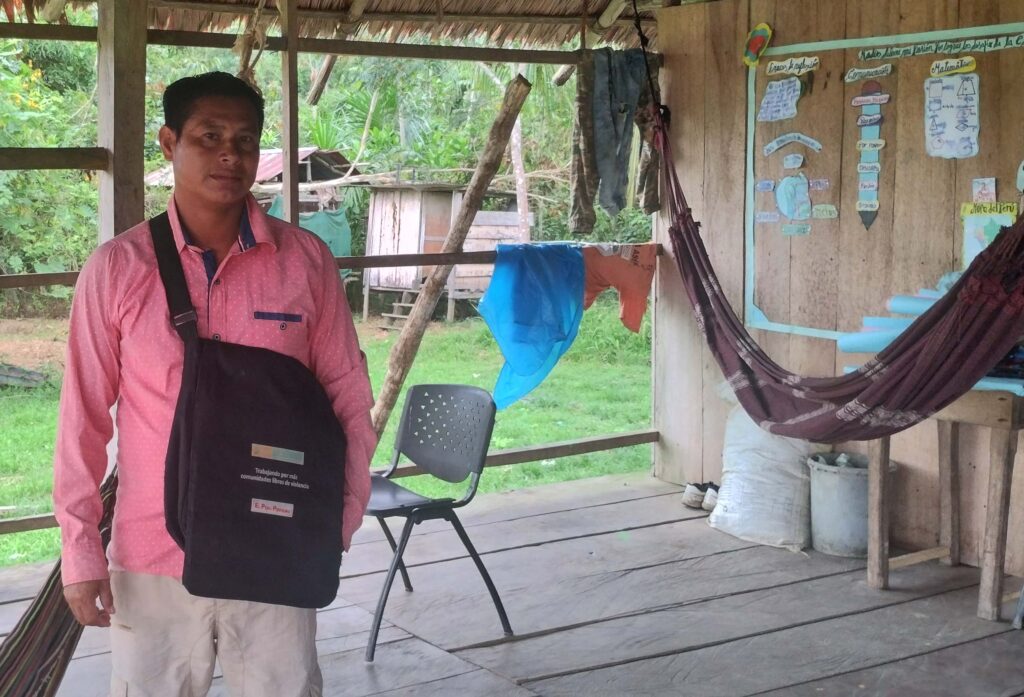
Orlando Rosero walks while he answers the questions. He points at some metal structures full of rust. “We see the ramps where they would put the [water] tank that we asked for so we’d have better water in the community. They said they’d come in a week, but two years have passed, and they never came back,” he says.
We see the ramps where they would put the [water] tank that we asked for so we’d have better water in the community. They said they’d come in a week, but two years have passed, and they never came back.
Orlando Rosero, Arabela elder from the Flor de Coco community
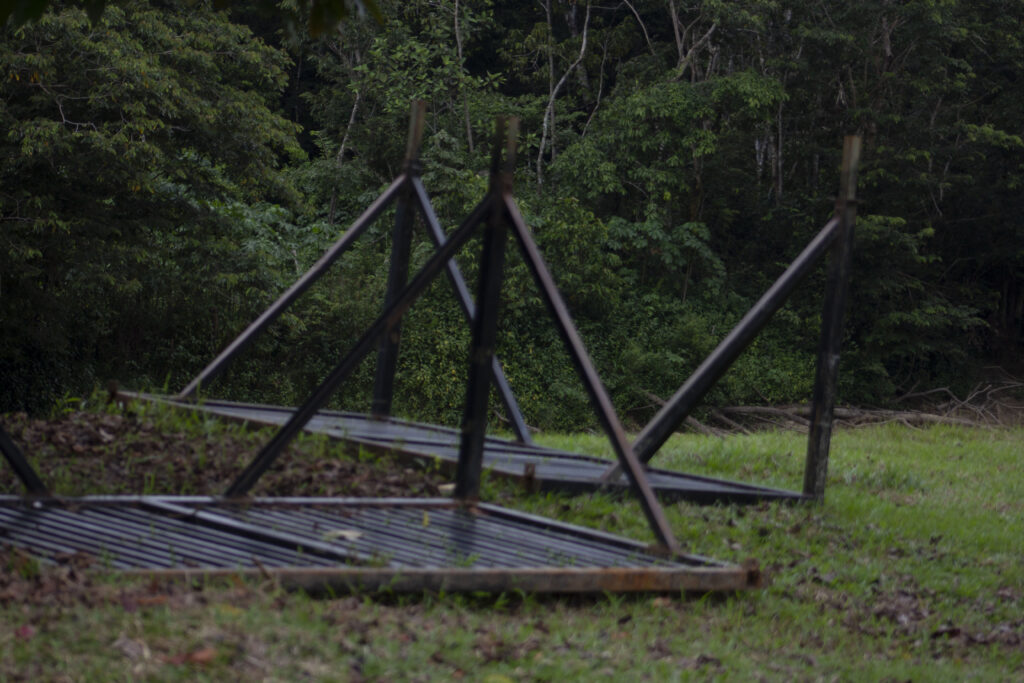
According to OEFA reports, Perenco failed to comply with its social responsibility duties on four occasions in the native communities of Buena Vista, Flor de Coco, Urbina-Rio Curaray, Shapajal and Bolívar. Such duties were provided for in the environmental management instrument, including productive projects, training and information sharing.“We were disappointed; people in the community will always say that Perenco has never been with us. If Perenco leaves, who will support us? Because we have always lived from hunting and fishing anyway,” the apu Manihuari adds.
We were disappointed; people in the community will always say that Perenco has never been with us. If Perenco leaves, who will support us? Because we have always lived from hunting and fishing anyway.
Jerónimo Manihuari, the apu, or chief, of the Flor de Coco native community
The necessary evil
In the midst of agreements and disagreements, the native communities of direct and indirect influence never opposed Perenco. However, the company has faced conflicts in the transit area of the barges that transport oil to station one of the North Peruvian Pipeline. In the native community of San Rafael, at the mouth of the Curaray River, about 8 hours from the area under Perenco’s direct and indirect influence, stoppages were frequent and could last for months.

According to Perenco, that situation has led the company to stop its operations in October 2022. According to community members, they have seen how tools and machinery were taken away and, most shockingly, how workers gradually disappeared.
Feconaca’s Cabrera states that Perenco’s withdrawal had a major impact on the communities. “Perenco’s departure has affected us since young men and women are leaving their homes because, without the company, their parents were left with little income. They stopped studying, they went to look for work, they migrated. Those who stayed are mostly older people; all the youth have already left,” she says with concern.
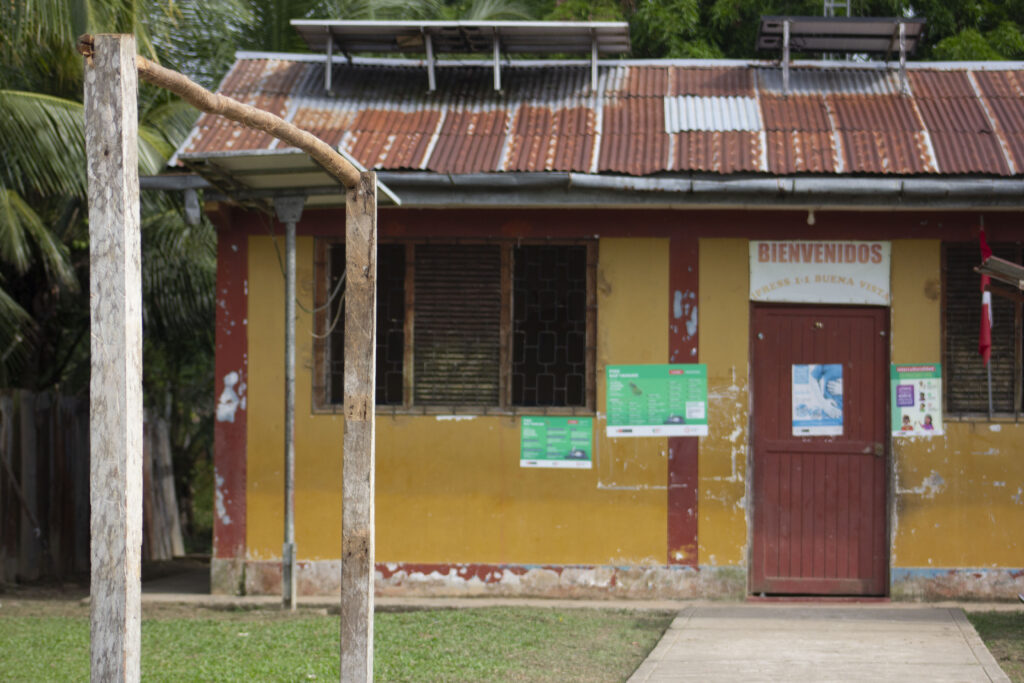
In September 2023, Perenco representatives called the Buena Vista and Flor de Coco native communities to an assembly to inform them of their reasons for “abandoning” the project. They were given three reasons: constant social conflicts reflected in strikes and social unrest; lack of guarantees from the State so that they could operate; and the threat posed to their investments by the creation of the PIACI Napo-Tigre reserve.
To date, Perenco has not formally requested to cease operating in Block 67 or filed a withdrawal plan. Perupetro, the state company in charge of promoting, subscribing and supervising oil contracts in Peru, explained that Perenco’s exploration and exploitation contracts are still effective for Blocks 67 and 39. The concession on the latter remains inoperative since 2014, and both are under “force majeure” status, that is, the company argues that it is being affected by fortuitous events that prevent it from fulfilling its duties.
An oil company that claims to be proud of its commitment to sustainability leaves many doubts about its concern for the ecosystems that surround its operations in the Amazon. Furthermore, as showed by the special investigation “The Perenco System,” the pattern is repeated in Africa and in its global activities overlapping more than 74 protected areas around the world. This is partly due to the lack of transparency with which it handles its violations but mostly to its lack of will to monitor environmental indicators. Without the instruments that determine how water, air and soil used to be before the company arrived and how they have evolved over the years, how can community members in the area under its direct and indirect influence know if they are being affected?
I’m sad because we have close communication with the company, but they were not sensible enough to inform us about what was happening. Now how many of us may have our bodies already affected? It’s a major concern.
Pilar Cabrera, president of the Federation of Native Communities of Alto Curaray and Arabela
Feconaca President Cabrera questions the State for abandoning the Arabela and Kichwa communities of the Upper Curaray, but she also confronts Perenco for not having warned them of the potential consequences of the violations for which the company has been sanctioned.“It’s not possible that, at this point, when Perenco is no longer operating, we find out that they have been sanctioned for environmental violations. And also I’m sad, because we have close communication with the company, but they were not sensible enough to inform us about what was happening. Now how many of us may have our bodies already affected? It’s a major concern,” she concludes.
*Translated to English by Roberto Cataldo
Investigative team
Local — Reporting: Pamela Huerta; data analysis: Luis Enrique Pérez; editing: Carolina Dantas; data visualization: Carolina Passos; direction: Juliana Mori
International — Alexandre Brutelle et Dorian Cabrol (Environmental Investigative Forum), Madeleine Ngeunga (InfoCongo), Juliana Mori (InfoAmazonia)
This investigation was supported by Journalismfund Europe.



